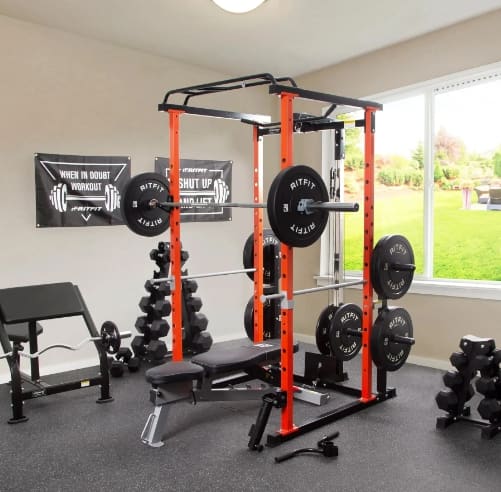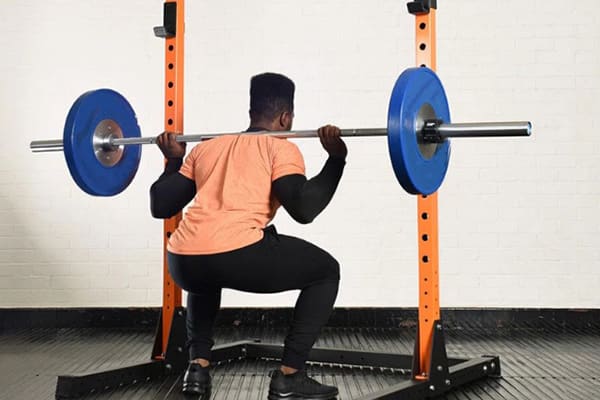Squat stands and power racks are foundational equipment in any gym, and they have become increasingly popular for home setups. Right alongside barbells and dumbbells, squat stands and power racks are essential for any serious strength training regimen. However, despite their shared importance, these two pieces of equipment are often confused. The confusion is understandable, given that both provide a stable place to rack your barbell for exercises like squats and bench presses. But there are key differences between squat stands and power racks; knowing these differences is crucial when outfitting your home gym.
What is a Power Rack?
A power rack, often referred to as a “power cage,” consists of four vertical posts forming a rectangular frame, which resembles an open cage. These posts are equipped with various features, including:
- J-hooks for holding the barbell at different heights.
- Safety straps or spotter arms for catching the barbell if it’s dropped.
- Pull-up bars for bodyweight exercises.
- Weight storage pegs for organizing your plates.
- Band pegs for resistance band training.
Power racks are highly versatile and can be customized with additional accessories like dip bars, lat pull-down attachments, and cable crossovers.
Uses of a Power Rack
A power rack is indispensable for a wide range of strength training exercises, particularly for those training alone without a spotter. It serves as a “mechanical spotter,” allowing you to safely perform heavy lifts without the need for a partner. Key exercises include:
- Squats: The rack supports the barbell at various heights, enabling you to perform squats safely.
- Bench Presses: With the barbell securely placed, you can bench press without worrying about dropping the bar.
- Pull-ups and chin-ups: The pull-up bar is perfect for upper-body workouts.
- Cable and pulley exercises: By adding attachments, you can incorporate a variety of movements targeting different muscle groups.
What is a Squat Stand?
At first glance, a squat stand may look similar to a power rack. However, it consists of just two upright posts instead of four, making it more compact and less versatile. Despite its simpler design, the squat stand is still effective for its intended purpose—holding the barbell for squats and bench presses.
Uses of a Squat Stand
Squat stands are primarily designed for:
- Squats: Position yourself under the barbell, lift it off the stand, perform your squats, and then re-rack the barbell.
- Bench Presses: The stand securely holds the barbell for your bench press routine.
Key Differences Between Squat Stands and Power Racks
The main differences between squat stands and power racks boil down to two factors: versatility and safety.
- Versatility: Power racks are far more versatile, accommodating a wider range of exercises beyond just squats and bench presses. They can be customized with various attachments, allowing for a more comprehensive workout. In contrast, squat stands are limited to a narrower range of exercises and typically do not support heavy weights or additional attachments.
- Safety: Power racks are designed with safety in mind. The inclusion of safety straps, spotter arms, and adjustable J-hooks ensures that even if you fail a lift, you can safely rack the barbell without risking injury. Squat stands generally lack these features, making them less safe, especially when lifting heavy. However, some squat stands, like those offered by Titan Fitness, come with safety attachments, adding a layer of security.
Benefits of a Power Rack
- Enhanced Versatility: Power racks support a broad spectrum of exercises, from squats to pull-ups, and can be further expanded with attachments.
- Superior Safety: With adjustable safety bars and spotter arms, power racks provide peace of mind when lifting heavy weights.
- Higher Weight Capacity: Power racks are built to handle more weight, making them ideal for serious lifters.
- Customizable: You can add various accessories to enhance your workout routine.
Benefits of a Squat Stand
- Space-Saving: Squat stands require less space and fit comfortably in home gyms with low ceilings.
- Cost-Effective: Squat stands are generally more affordable, making them a good option for those on a budget.
- Simplicity: For those who primarily focus on squats and bench presses, squat stands offer a straightforward and compact solution.
In summary, while both squat stands and power racks serve similar functions, they cater to different needs. Power racks offer more versatility and safety, making them ideal for those who want a comprehensive and secure workout experience. Squat stands, on the other hand, are perfect for those with limited space or a more focused workout routine.
If you’re ready to choose fitness equipment to optimize your strength training regimen, you’ll find that a squat rack or squat stand can take your exercise routine to a whole new level. No matter which you decide to purchase, Hongxing Fitness is happy to answer any questions you may have.
Post time: 08-19-2024





